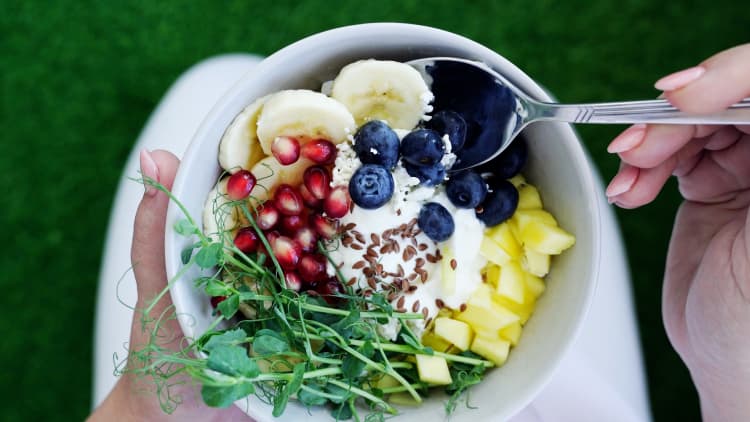Growing up in Nara, Japan, surrounded by tea fields, matches it has always been a part of my life. The full aroma and deep bittersweet umami taste of this vibrant green tea evokes so much nostalgia for me.
When I was in high school, I began taking formal tea ceremony lessons. It was a highlight of my week. Our tea master would always give me and my classmates delicious seasonal Japanese wagashi (sweets) and flowers, and she invited us to watch and help during her tea ceremony at a prestigious temple in Kyoto.
I still perform regularly Everytraditional Japanese tea ceremony for making green tea. I stopped for a while when I moved to the States, but resuming my practice here in New York has given me a valuable sense of community.
DON’T MISS: Are you stressed about money? Take our new online course
More than anything, I socialize matches with the wisdom of my elders. My 99-year-old aunt and my 98-year-old mentor, whom I call Papa-sanhave done theirs matches for most of their lives. I even inherited some of them matches bowls and dishes.
Matcha it’s my no. 1 for longevity and I drink it every day.
Here I am offering a tea ceremony and lecture to the community in Beacon, New York.
Photo: Michiko Tomioka
Health benefits of matcha
A delicious batch of vegan matcha cupcakes.
Photo: Michiko Tomioka
Studies have also shown that matches it can reduce the risk of cardiovascular disease and can improve your gut health as well.
There are many ways to consume matchesincluding desserts like cupcakes, cookies, chia pudding and mochi.
How to get a bowl of matcha the traditional way
If you ever get the chance to attend one Chakai (tea gathering) or served in a formal setting, there are certain rules that must be followed – these are some of the main ones.
When served, say “Okemae chodai Itashimasu”, which means “Thank you for serving me tea.” Then take the bowl, hold it with both hands, look at the color for a moment and enjoy.
My daily matcha with my 99-year-old aunt’s tea.
Photo: Michiko Tomioka
When you are done, look at the container again and hold it carefully in both hands. Then take it back to the place where you were served.
The most important thing is to express your appreciation, relax and embrace the moment.
How I prepare my matcha bowl every day
My day starts with a prayer and a bowl of matches for my ancestors. Then I make a bowl for myself and one for my son before he goes to work as a physical therapist. This daily ritual to perform Every it fills me with such a sense of peace.
Here are the steps I do:
- I boil about two ounces of water.
- I put half a cup of hot water in my bowl and with it follower (bamboo tea whisk), I swirl the water a few times to clean my utensils. Takayama, a village in my home in Nara, is famous for manufacturing follower.
- I drain the water and then wipe everything off with a clean cloth or paper towel.
- With mine chashaku (traditional bamboo tea spoon), I measure two grams of green matches powder and place at the bottom of the bowl.
- I slowly pour about 60ml of hot water over the powder and enjoy the aroma that emerges.
- I hold the bowl carefully in my left hand and shake it, making sure to keep it follower vertically, for about 20 seconds. I call this my “Gift of the Zen Moment”.
In Japan, making my own tea spoon at Master Tango Tanimura’s house in Takayama, Nara. The Tanimura family has been making tea whisks for nearly 500 years.
Photo: Michiko Tomioka
During the summer, I’ll sometimes transfer the brewed tea to a portable thermos and add about half a cup of crushed ice for a refreshing, cool treat.
One of my favorite creators matches is the Ippodo tea company. It is based in Kyoto and has been in operation since the 1700s. I also recommend using bamboo tea whisks, which you can often find in Asian grocery stores or online.
If you’re just starting out, you can always use a small kitchen whisk or even a jar with a lid – but no blender, please. matches the powder is so delicate.
After completing this meditative routine, I always feel a little lighter. Simply put, it is healing.
Michiko TomiokaMBA, RDN, is a certified nutritionist and longevity expert. Born and raised in Nara, Japan, her approach focuses on a plant-based diet. She has worked in nutrition roles at substance recovery centers, charter schools and food banks. Follow him on Instagram @michian_rd.
Are you stressed about money? Sign up for CNBC’s new online course. We’ll teach you how to be more successful and secure with your money, and practical strategies to increase savings, get out of debt and invest for the future. Get started today and use code EARLYBIRD for a 30% introductory discount until September 2, 2024.
